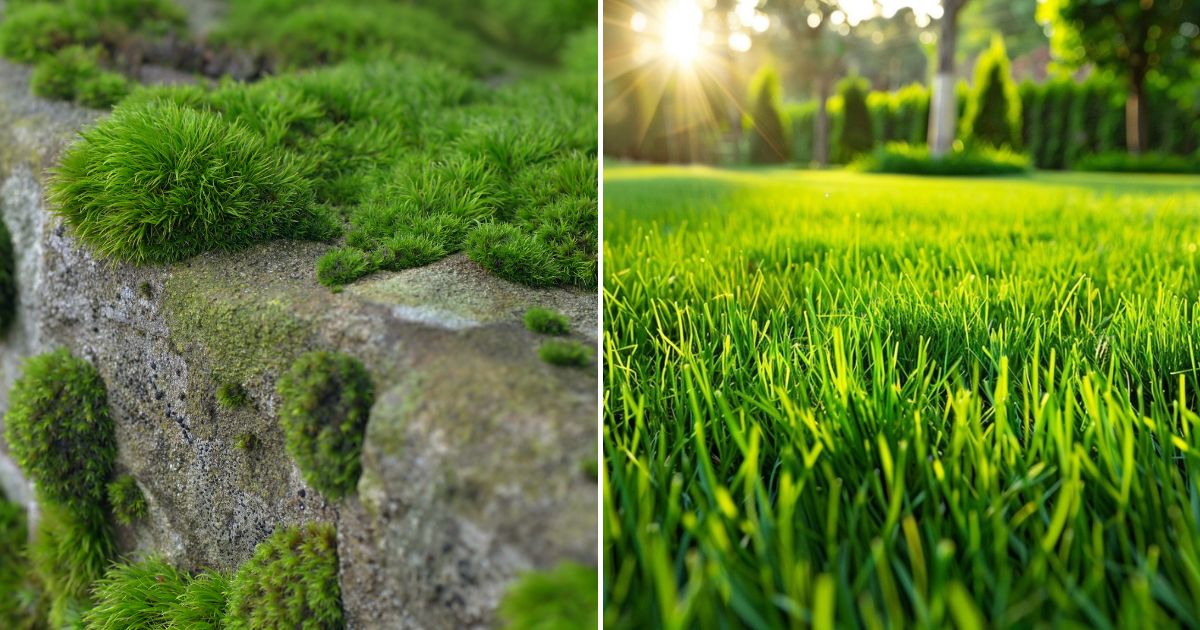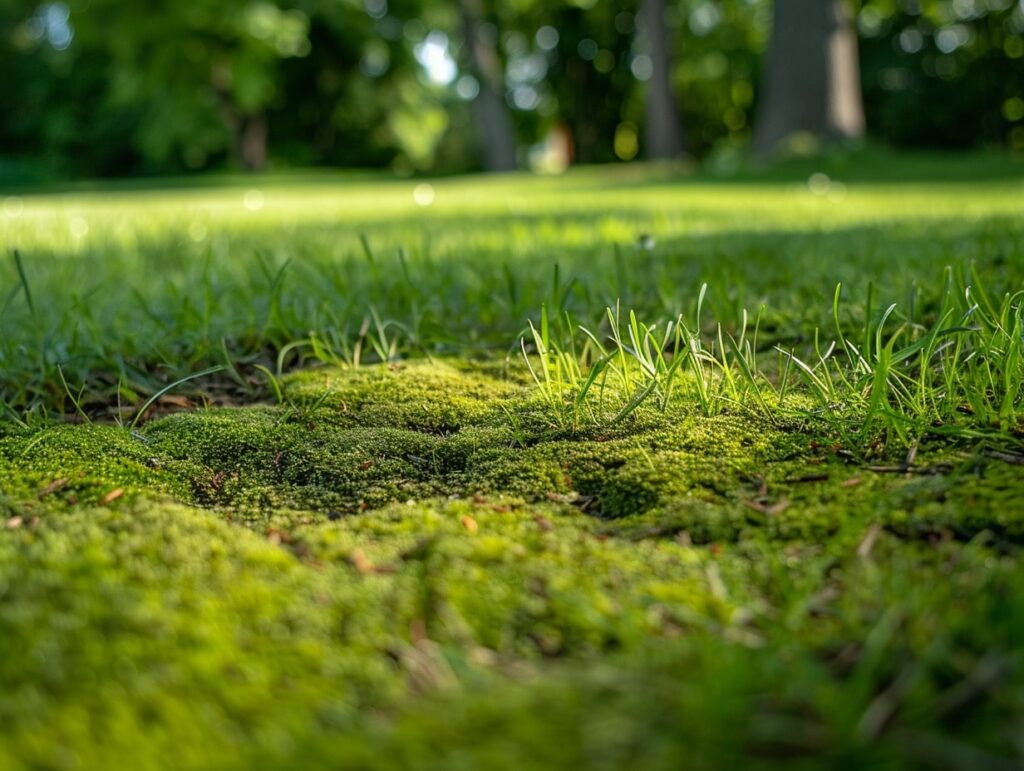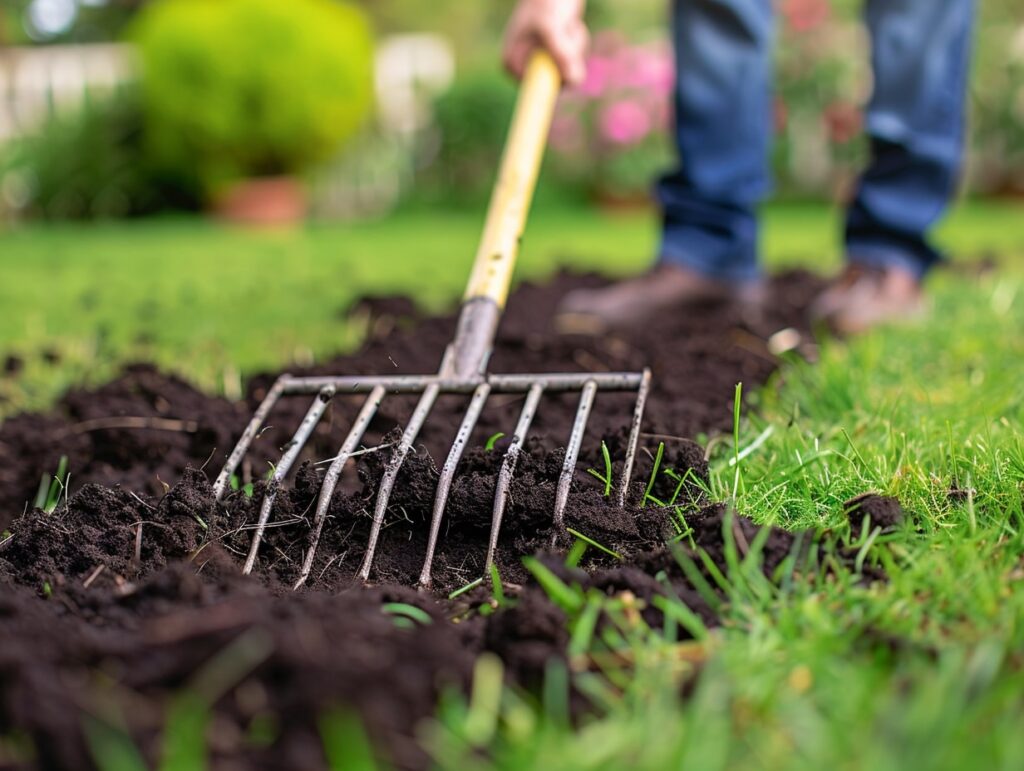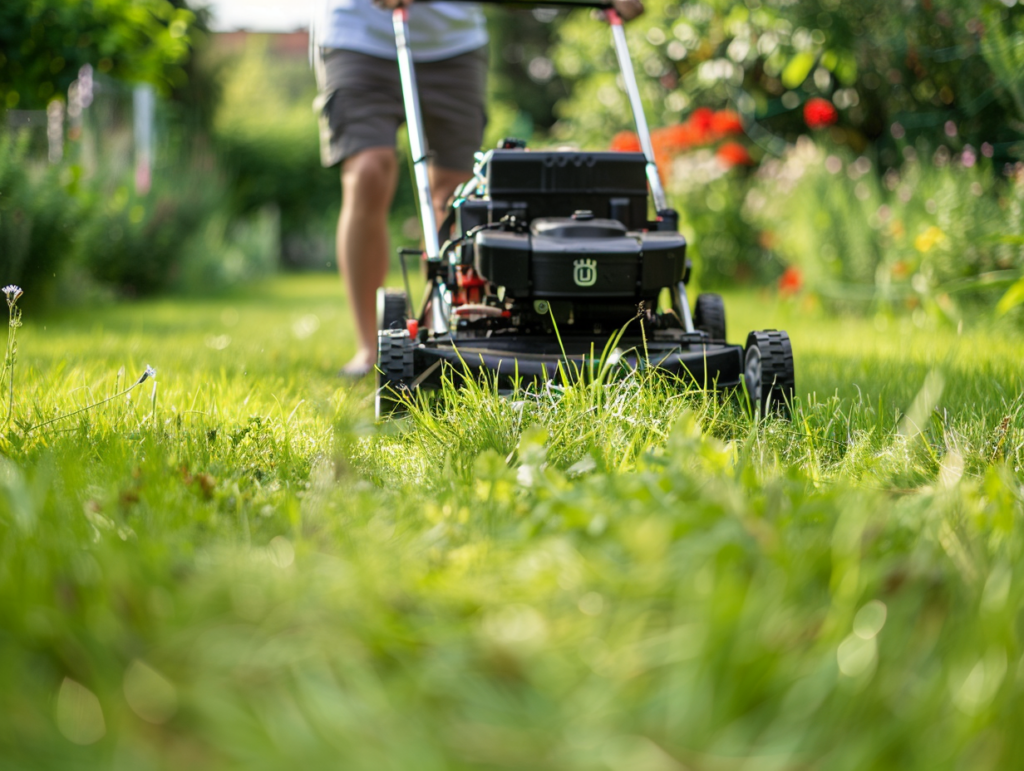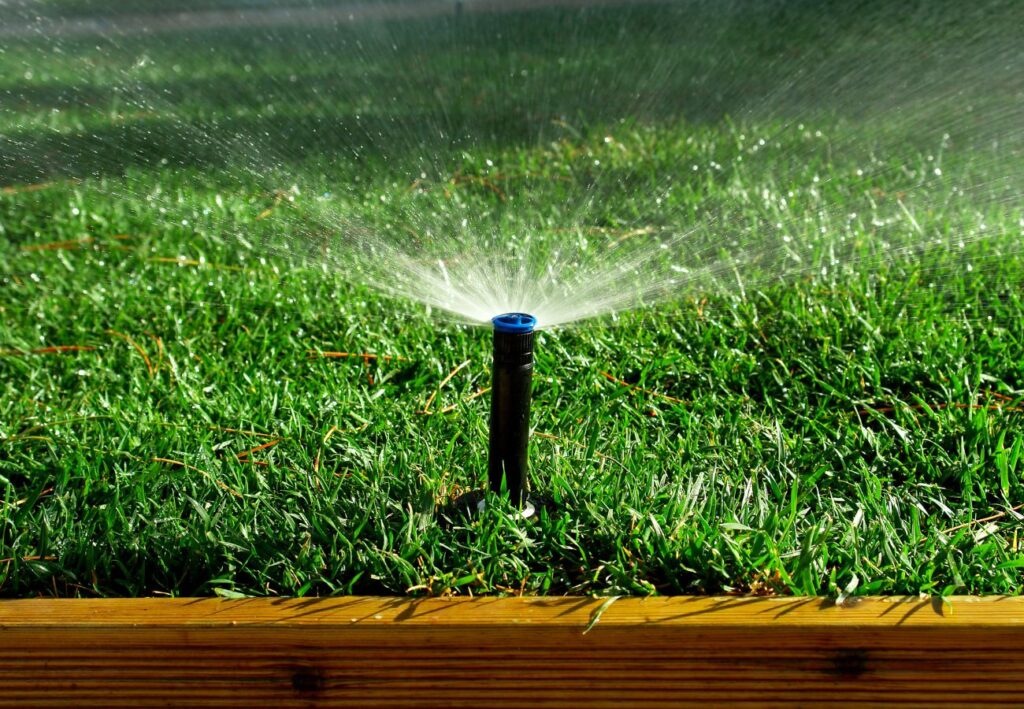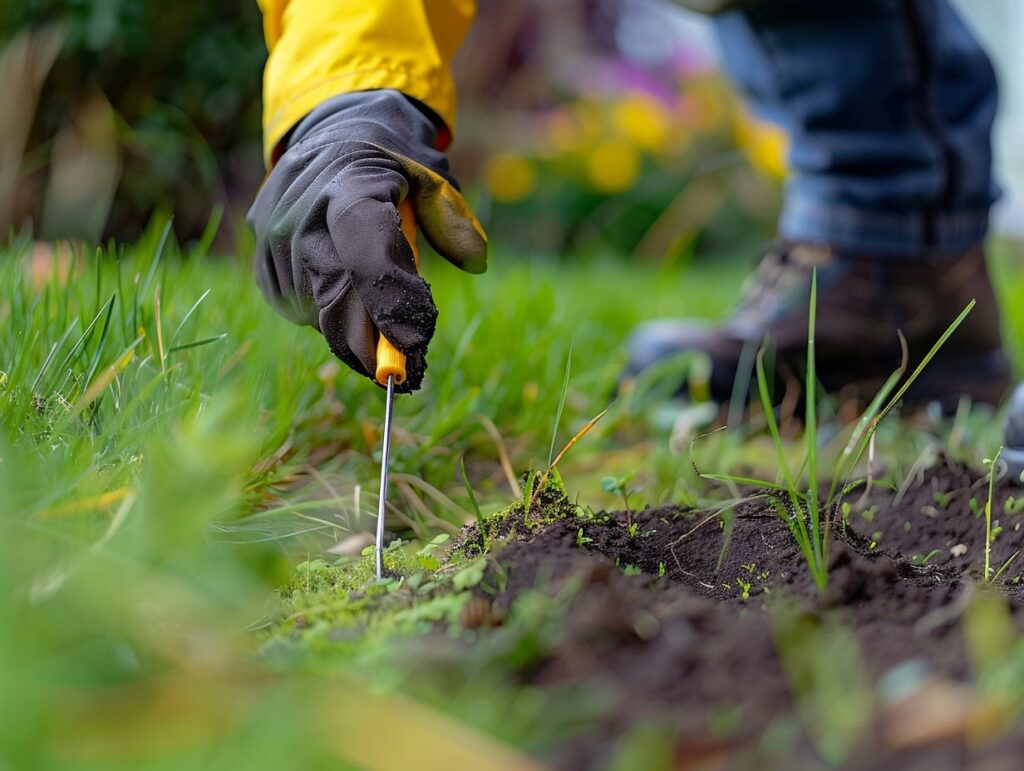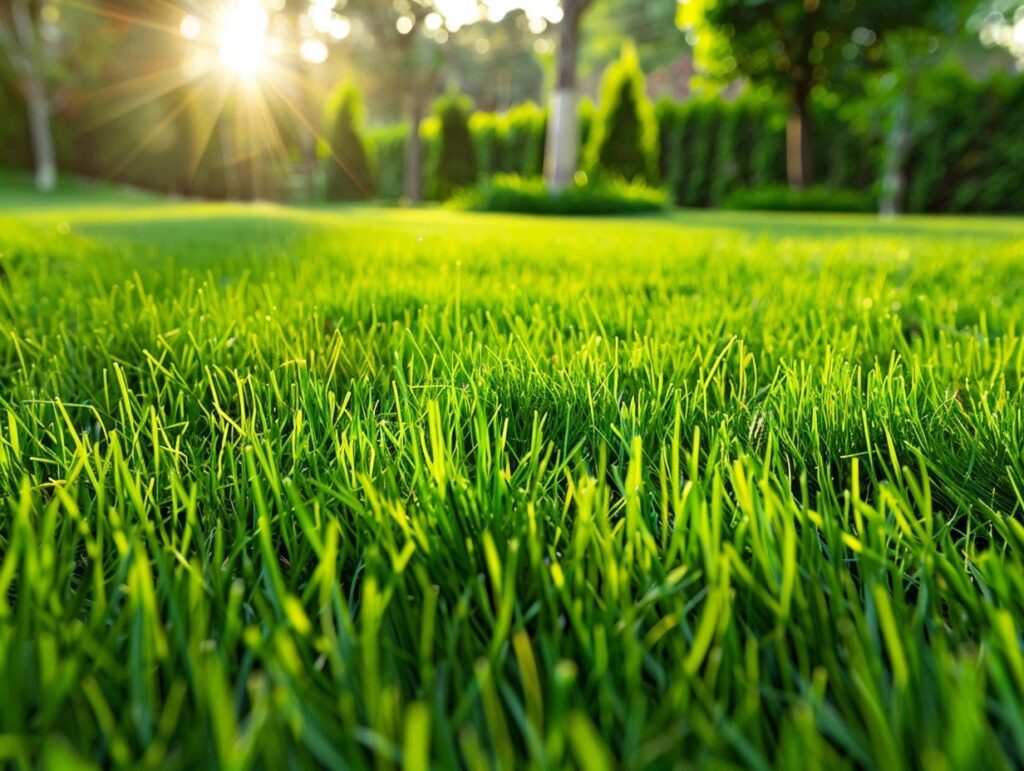Moss taking over your lawn can be frustrating, but there’s hope. By improving drainage, reducing shade, and keeping your soil healthy, you can effectively manage and prevent moss growth.
These changes not only tackle the moss problem but also promote a vibrant and lush lawn.
Start by checking your lawn’s drainage. Spoiler alert: moss loves wet, poorly drained areas. Switch things up by aerating your soil and ensuring it isn’t compacted. This helps the excess water drain away, giving your prized grass a better chance to thrive.
Another tip is to manage the shade in your yard. Moss thrives in shady spots, so consider trimming back overhanging branches to let more sunlight reach the ground. This simple step can dramatically reduce moss growth and promote healthier grass.
Understanding Moss in Lawns
Moss can appear in your lawn for several reasons, including poor drainage and acidic soil. Recognizing the characteristics of moss and understanding its causes are key steps in managing and preventing its growth.
Characteristics of Moss
Moss is a simple, non-vascular plant that thrives in moist and shady environments. It lacks true roots, stems, and leaves, relying on spores for reproduction.
Moss’s growth habit involves forming dense mats or tufts, which can feel spongy underfoot. Common mosses found in lawns include Bryum, Polytrichum, and Hypnum.
These plants have a high tolerance for poor soil conditions. You’ll typically see moss in areas where grass struggles to grow, indicating it’s often a symptom of underlying issues.
Causes of Moss Growth
Several factors contribute to moss growth in lawns. Shady areas prevent sufficient sunlight from reaching the grass, creating a favorable environment for moss. Poor drainage can lead to waterlogged soil, another condition moss prefers.
Soil acidity also plays a role. Moss thrives in acidic soils (pH below 6), while grass prefers neutral pH levels. Compacted soil restricts grass roots from spreading and accessing nutrients, giving moss the upper hand.
Lack of nutrients can weaken grass, making it easier for moss to establish itself. Regular mowing at the proper height and maintaining healthy grass are essential prevention strategies.
Cultural Control Methods
To tackle moss in your lawn, you can focus on improving soil conditions and ensuring your lawn receives adequate sunlight and care.
Improving Soil Drainage
Moss often thrives in areas with poor drainage. Ensure your lawn has a proper grading to direct water away from low spots. You can create drainage channels or install a French drain to help manage excess water.
Core aeration, which removes small plugs of soil, can also enhance drainage by allowing water to penetrate the soil more efficiently.
Adjusting Soil pH
Moss tends to grow in acidic soils. Testing your soil’s pH is essential for managing moss. Ideally, lawn pH should be between 6.0 and 7.0. If your soil is too acidic, you can add lime to increase the pH.
Follow application instructions carefully and apply lime in the fall or spring for best results.
Increasing Sunlight Exposure
Shady areas are prime spots for moss growth. Trim back trees or shrubs that block sunlight from reaching your lawn. If certain areas remain shaded despite your efforts, consider planting shade-tolerant grass species.
Be persistent in keeping your lawn free from excessive shade, as it promotes healthier grass and discourages moss.
Lawn Aeration and Dethatching
Lawn aeration improves soil compaction and allows oxygen, water, and nutrients to reach grass roots more effectively. Dethatching removes the layer of dead grass and organic material that can prevent grass growth and encourage moss.
Regular maintenance through aeration and dethatching can significantly reduce moss by promoting a healthier lawn environment.
Chemical Control Options
Chemical control methods allow you to target moss effectively and can be a practical solution when dealing with large infestations. It’s important to choose the right chemical and apply it correctly.
Selecting Moss Killers
When choosing a moss killer, look for products containing iron sulfate or ferrous ammonium sulfate. These compounds are effective at killing moss by burning and drying it out.
There are granular options available that you can spread with a fertilizer spreader. Liquid moss killers are also an option and can be diluted in water and sprayed over the affected areas. Always read the label for application instructions and safety precautions.
It’s helpful to select a moss killer that suits your lawn size and severity of the moss problem. Many products are available in both liquid and granular forms, each with unique benefits.
Application Techniques
For granular moss killers, use a drop or broadcast spreader to ensure even distribution. Water the lawn lightly after applying to activate the chemicals.
When using liquid moss killers, a garden sprayer or hose-end attachment can help you cover large areas uniformly. Apply on a calm, dry day to prevent the chemicals from washing away or drifting to unintended areas.
Always wear protective gear, such as gloves and goggles, to prevent contact with the chemicals. Follow the product instructions for the correct dilution rates and application frequencies for best results.
Maintaining a Healthy Lawn
Keeping your lawn in top shape involves regular mowing, following a proper fertilization schedule, and adhering to appropriate watering guidelines. These practices are crucial for a lush, green lawn that resists moss growth.
Regular Mowing Practices
Mowing your lawn correctly is essential. Aim to mow your lawn once a week during the growing season. Set your mower blades to a height of 2.5 to 3 inches. This height promotes strong root growth and thick grass.
Avoid cutting more than one-third of the grass height at a time. Sharp mower blades give a clean cut and help prevent disease. Always mow when the grass is dry to avoid clumping and uneven cuts.
Fertilization Schedule
Fertilizing your lawn provides essential nutrients. Apply a balanced fertilizer in early spring and late summer. You can use either granular or liquid fertilizers, depending on your preference and the specific needs of your lawn.
Recommended nutrient ratios are often displayed as N-P-K, which stands for nitrogen, phosphorus, and potassium. Choose a fertilizer with a ratio such as 10-10-10 or 20-10-10. Always follow product instructions for application rates to avoid over-fertilization.
Watering Guidelines
Proper watering keeps your lawn hydrated and healthy. Water your lawn deeply and infrequently. Aim for around 1 inch of water per week, including rainfall, to promote deep root growth.
Early morning is the best time to water. Avoid midday watering, as much of the water can evaporate before it is absorbed. Evening watering is not ideal because it can lead to fungal growth. Use a sprinkler system or a soaker hose for even coverage.
Professional Lawn Care Advice
Professional lawn care services can provide significant expertise and specialized treatments to deal with moss in your lawn. Below are details on when to seek expert help and the benefits of professional assessment.
When to Seek Expert Help
If you’ve tried DIY treatments and the moss keeps returning, it might be time to consult a professional. Persistent moss could indicate underlying issues such as poor drainage, acidic soil, or compacted turf that require specialized solutions.
Professionals can also help if you’re unsure of the cause of the moss. They have the tools and experience to diagnose issues correctly. Seek expert advice at the start of the growing season to implement preventive measures.
Benefits of Professional Assessment
A professional assessment includes a thorough lawn analysis. Experts check for soil pH, compaction, and drainage problems. They provide a tailored treatment plan that addresses both symptoms and underlying issues.
Using professional services saves you time and effort. It also ensures that treatments are applied correctly and effectively. Professionals often have access to high-quality products not available to the public, enhancing treatment efficacy.
Investing in expert lawn care can lead to a healthier, more resilient lawn, reducing the likelihood of future moss problems.
By following these comprehensive strategies, you can successfully manage and prevent moss growth in your lawn. Improving drainage, reducing shade, and maintaining healthy soil are crucial steps that not only combat moss but also promote a lush, vibrant lawn.
Regular maintenance practices such as proper mowing, fertilization, and watering further support the health of your grass, ensuring it remains resilient against moss invasion.
When DIY efforts fall short, seeking professional lawn care services can provide specialized solutions and expert advice tailored to your lawn’s specific needs.
With persistence and the right approach, you can transform your moss-prone lawn into a thriving green space, enhancing the beauty and enjoyment of your outdoor environment.
